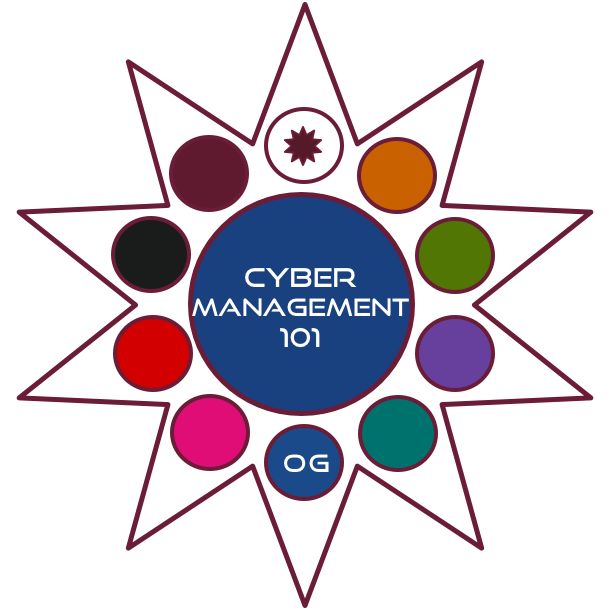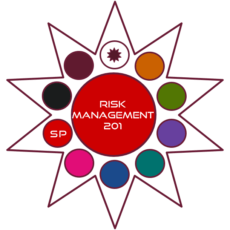Description
This course will help students to demonstrate knowledge and advance a career in Cybersecurity Management. Each student must be on the way to the CISO role. This will sharpen that skill with deliberate practice.
Students will become cybersecurity professional community members.
Practice in this course will lead to excellence in Cybersecurity Management.
It shows students have what it takes to design, engineer, implement and run an information security program.
We deliver training live-on-line, on site, and on demand.
If your organization would like this course at a particular time or location, it is available for groups greater than 8 with a contract.
CISSP
- Certified Information Systems Security Professional is an independent information security certification.
- As of 1 January 2018, there are 122,289 CISSPs worldwide.
- Governing Body: International Information System Security Certification Consortium (ISC)²
- External exam costs: $699 in United States
- Price does/does not include exam
https://www.isc2.org/Certifications/CISSP
CCISO
- Certified Chief Information Security Officer
- Governing Body: Eccouncil
- External exam costs: $1099 in United States
- Price does/does not include exam
Security / Managerial / Certification
This course fulfills NICE/NICCS Categories and Role:
- Oversee and Govern (OG) Information Systems Security Manager OV-MGT-001
This is a DOD 8570 compliant course for the following roles:
- IAT III, IAM III,IASAE II, CSSP Ma
Since the computing environment specific to tools is critical to success in the field, we offer the tools and operating systems in our cyber range setup that match most students’ live environment.
DOD acronyms
- Information Assurance Technical (IAT)
- Information Assurance Management (IAM)
- Computer Network Defense Service Providers (CND-SPs)
- IA System Architects and Engineers (IASAEs)
- Cyber Security Service Providers (CCSP)
- Analyst – An
- Infrastructure support -In
- Incident responder – Ir
- Auditor – Au
- Manager – Ma
We expect every student to achieve the knowledge, skills, and abilities necessary to develop and support an enterprise security program. As a side benefit of the course, students will pass the CISSP exam and validate their skills as a cybersecurity professional via certification.
- Identify and use computer networking concepts, protocols, and network security methodologies.
- Understand basic risk management processes.
- Execute secure network administration principles.
- Distinguish and differentiate cyber threats and vulnerabilities.
- Replace suitable certification for security experience such as with CompTIA Security+.
- Configure and implement virtual machine and basic virtual network environments.
- Configure and implement client server operating systems of both Linux and Microsoft.
- Knowledge and skills necessary to troubleshoot, install, operate and configure basic network infrastructure.
- Replace suitable certification for technical experience such as with CompTIA Network+.
- Manage a team of three for two years.
- Perform team member evaluations.
- Write and/or review vendor contracts, statements of work, or memorandums of understanding.
Upon completion of the course the student should be able to oversee the cybersecurity program of an information system or network, including managing information security implications within the organization, specific program, or other area of responsibility, to include strategic, personnel, infrastructure, requirements, policy enforcement, emergency planning, security awareness, and other resources. They will be responsible for the cybersecurity of a program, organization, system, or enclave.
- Computer networking concepts and protocols, and network security methodologies.
- Risk management processes.
- Laws, regulations, policies, and ethics as they relate to cybersecurity and privacy.
- Cybersecurity and privacy principles.
- Cyber threats and vulnerabilities.
- Specific operational impacts of cybersecurity lapses.
- Applicable business processes and operations of customer organizations.
- Encryption algorithms
- Data backup and recovery.
- Business continuity and disaster recovery continuity of operations plans.
- Network access control mechanisms.
- Cybersecurity and privacy principles used to manage risks related to the use, processing, storage, and transmission.
- Vulnerability information dissemination sources.
- Incident response and handling methodologies.
- Industry-standard and organizationally accepted analysis principles and methods.
- Intrusion detection methodologies and techniques for detecting host and network-based intrusions.
- Risk management framework requirements.
- Measures or indicators of system performance and availability.
- Industry methods for evaluating, implementing, and disseminating security assessment, monitoring, detection, and remediation tools.
- Network traffic analysis methods.
- New information technology and cybersecurity technologies.
- How traffic flows across the network.
- System and application security threats and vulnerabilities.
- Resource management principles and techniques.
- Server administration and systems engineering theories, concepts, and methods.
- Server and client operating systems.
- System software and organizational design standards, policies, and authorized approaches relating to system design.
- System life cycle management principles, including software security and usability.
- Technology integration processes.
- The organization’s enterprise information technology goals and objectives.
- What constitutes a network attack and the relationship to threats and vulnerabilities.
- Information security program management and project management principles and techniques.
- Supply chain risk management practices
- Organization’s risk tolerance and/or risk management approach.
- Enterprise incident response program, roles, and responsibilities.
- Current and emerging threat vectors.
- Critical information technology procurement requirements.
- System administration, network, and operating system hardening techniques.
- Applicable laws, statutes, presidential directives, executive branch guidelines, and legal guidelines and procedures.
- Information technology supply chain security risk management policies, requirements, and procedures.
- Critical infrastructure systems that were designed without security considerations.
- Network security architecture concepts including topology, protocols, components, and principles.
- Network systems management principles, models, methods, and tools.
- Security architecture concepts and enterprise architecture reference models.
- Personally identifiable information data security standards.
- Payment card industry data security standards.
- Personal health information data security standards.
- Laws, policies, procedures, or governance relevant to cybersecurity for critical infrastructures.
- An organization’s information classification program and procedures for information compromise.
- Network protocols.
- Penetration testing principles, tools, and techniques.
- Controls related to the use, processing, storage, and transmission of data.
- Application security risks
- Creating policies that reflect system security objectives.
- Determining how a security system should work and how changes in conditions, operations, or the environment will affect these outcomes.
- Evaluating the trustworthiness of the supplier and/or product.
- Apply techniques for detecting host and network-based intrusions using intrusion detection technologies.
- Integrate information security requirements into the acquisition process; using applicable baseline security controls as one of the sources for security requirements; ensuring a robust software quality control process; and establishing multiple sources.
- Acquire and manage the necessary resources to support security goals and objectives and reduce overall organizational risk.
- Acquire necessary resources to conduct an effective enterprise continuity of operations program.
- Advise senior management on risk levels and security posture.
- Advise senior management on cost/benefit analysis of information security programs, policies, processes, systems, and elements.
- Advise appropriate senior leadership or authorizing official of changes affecting the organization’s cybersecurity posture.
- Collect and maintain data needed to meet system cybersecurity reporting.
- Communicate the value of information technology security throughout all levels of the organization stakeholders.
- Collaborate with stakeholders to establish the enterprise continuity of operations program, strategy, and mission assurance.
- Ensure that security improvement actions are evaluated, validated, and implemented as required.
- Ensure that cybersecurity inspections, tests, and reviews are coordinated for the network environment.
- Ensure that cybersecurity requirements are integrated into the continuity planning for that system and/or organization.
- Ensure that protection and detection capabilities are acquired or developed using the is security engineering approach and are consistent with organization-level cybersecurity architecture.
- Establish overall enterprise information security architecture with the organization’s overall security strategy.
- Evaluate and approve development efforts to ensure that baseline security safeguards are appropriately installed.
- Evaluate cost/benefit, economic, and risk analysis in decision-making process.
- Identify alternative information security strategies to address organizational security objective.
- Identify information technology security program implications of new technologies or technology upgrades.
- Interface with external organizations to ensure appropriate dissemination of incident information.
- Interpret and/or approve security requirements relative to the capabilities of new information technologies.
- Interpret patterns of noncompliance to determine their impact on levels of risk.
- Lead and align information technology security priorities with the security strategy.
- Lead and oversee information security budget, staffing, and contracting.
- Manage the monitoring of information security data sources to maintain organizational situational awareness.
- Manage the publishing of computer network defense guidance for the enterprise constituency.
- Manage threat or target analysis of cyber defense information and production of threat information within the enterprise.
- Monitor and evaluate the effectiveness of the enterprise’s cybersecurity safeguards.
- Oversee the information security training and awareness program.
- Participate in an information security risk assessment during the security assessment and authorization process.
- Participate in the development or modification of the computer environment cybersecurity program plans and requirements.
- Prepare, distribute, and maintain administrative controls concerning the security of network system operations.
- Provide supply chain risk management guidance for development of the continuity of operations plans.
- Provide leadership and direction to information technology personnel commensurate with their responsibilities.
- Provide system-related input on cybersecurity requirements for statements of work and procurement documents.
- Recognize a possible security violation and take appropriate action to report the incident, as required.
- Recommend resource allocations required to securely operate and maintain an organization’s cybersecurity requirements.
- Recommend policy and coordinate review and approval.
- Supervise or manage protective or corrective measures when a cybersecurity incident or vulnerability is discovered.
- Track audit findings and recommendations to ensure that appropriate mitigation actions are taken.
- Use federal and organization-specific published documents to manage operations of their computing environment system.
- Promote awareness of security issues among management and ensure sound security principles are reflected in the organization’s vision and goals.
- Oversee policy standards and implementation strategies to ensure procedures and guidelines comply with cybersecurity policies.
- Participate in risk governance process to provide security risks, mitigations, and input on other technical risk.
- Evaluate the effectiveness of procurement function in addressing information security requirements and supply chain risks through procurement activities and recommend improvements.
- Identify security requirements specific to an information technology system in all phases of the system life cycle.
- Ensure that plans of actions and milestones or remediation plans are in place for vulnerabilities identified during risk assessments, audits, inspections, etc.
- Assure successful implementation and functionality of security requirements and appropriate information technology policies and procedures that are consistent with the organization’s mission and goals.
- Support necessary compliance activities.
- Participate in the acquisition process as necessary, following appropriate supply chain risk management practices.
- Ensure that all acquisitions, procurements, and outsourcing efforts address information security requirements consistent with organization goals.
- Continuously validate the organization against policies/guidelines/procedures/regulations/laws to ensure compliance.
- Forecast ongoing service demands and ensure that security assumptions are reviewed as necessary.
- Define and/or implement policies and procedures to ensure protection of critical infrastructure as appropriate.
All courses are available in live-on-line format.
There are 11 different methods of possible exercises used throughout the course in one-hour class meetings. As soon as students become accustomed to a particular flow, or they get comfortable, the instructor will switch methods. Some examples include: threats and controls, case studies, risk analysis practice, and reading review. Technical labs will require basic skills in operating systems and virtualization.
Before class students will complete mindmaps, assigned readings, take practice quizzes, submit case study information, and build flashcards. Each activity is graded as needed.
We use a customized text developed by our internal experts. This text covers the latest best practices, current state of security and technology. All students are required to have a working computer, microphone, and earbuds.
- 1 hour per session
- 5 sessions per week
- 10 weeks with 2 break weeks (also called ‘dark weeks’)
- Orientation is held for 90 minutes before first live class.
- Class meeting times are listed on the public calendar.


